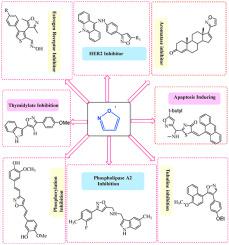European Journal of Medicinal Chemistry ( IF 6.0 ) Pub Date : 2021-05-06 , DOI: 10.1016/j.ejmech.2021.113511 Girish Chandra Arya 1 , Kamalpreet Kaur 1 , Vikas Jaitak 1

|
Breast cancer is the second most leading cause of death among women. Multiple drugs have been approved by FDA for the treatment of BC. The major drawbacks of existing drugs are the development of resistance, toxicity, selectivity problem. The other therapies like hormonal therapy, surgery, radiotherapy, and immune therapy are in use but showed many side effects like bioavailability issues, non-selectivity, pharmacokinetic-pharmacodynamic problems. Therefore, there is an urgent need to develop new moieties that are nonviolent and more effective in the treatment of cancer. Isoxazole derivatives have gain popularity in recent years due to anticancer potential with the least side effects. These derivatives act as an anticancer agent with different mechanisms like inducing apoptosis, aromatase inhibition, disturbing tubulin congregation, topoisomerase inhibition, HDAC inhibition, and ERα inhibition. In this article, we have explored the synthetic strategies, anticancer mechanism of action along with SAR studies of isoxazole derivatives.
中文翻译:

异恶唑衍生物作为抗癌剂:合成策略、作用机制和 SAR 研究综述
乳腺癌是导致女性死亡的第二大原因。多种药物已被 FDA 批准用于治疗 BC。现有药物的主要缺点是产生耐药性、毒性、选择性问题。其他疗法如激素疗法、手术、放射疗法、和免疫疗法正在使用中,但显示出许多副作用,如生物利用度问题、非选择性、药代动力学-药效学问题。因此,迫切需要开发非暴力且在癌症治疗中更有效的新部分。由于具有最小副作用的抗癌潜力,异恶唑衍生物近年来越来越受欢迎。这些衍生物作为抗癌剂具有不同的机制,如诱导细胞凋亡、芳香酶抑制、干扰微管蛋白聚集、拓扑异构酶抑制、HDAC 抑制和 ERα 抑制。在本文中,我们探讨了异恶唑衍生物的合成策略、抗癌作用机制以及 SAR 研究。


















































 京公网安备 11010802027423号
京公网安备 11010802027423号